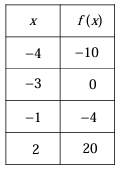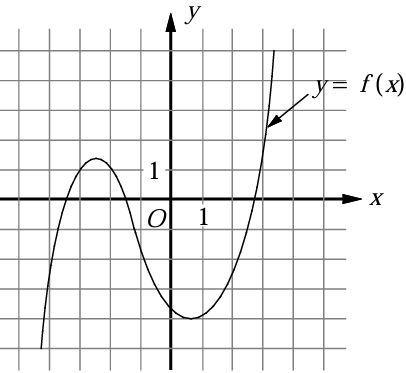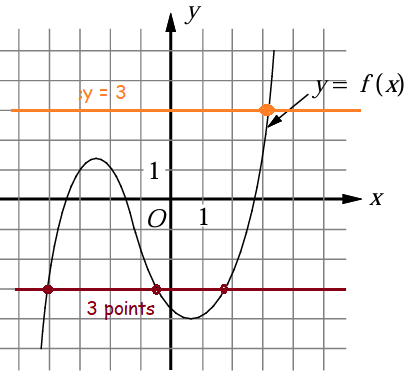POLYNOMIAL FUNCTIONS AND THEIR GRAPHS SAT
Subscribe to our ▶️ YouTube channel 🔴 for the latest videos, updates, and tips.
Problem 1 :
If -1 and 1 are two real roots of the polynomial function
f(x) = ax3 + bx2 + cx + d
and (0, 3) is the y-intercept of graph f, what is the value of b ?
a) -3 b) -1 c) 2 d) 4
Solution :
Since -1 and 1 are real roots of the polynomial function,
f(1) = 0 and f(-1) = 0
f(x) = ax3 + bx2 + cx + d
f(1) = a(1)3 + b(1)2 + c(1) + d
a + b + c + d = 0 -----(1)
f(-1) = a(-1)3 + b(-1)2 + c(-1) + d
-a + b - c + d = 0 -----(2)
Since (0, 3) is one of the points of the polynomial, we get
3 = a(0)3 + b(0)2 + c(0) + d
3 = d
(1) + (2)
a + b + c + d + (-a + b - c + d) = 0
2b + 2d = 0
b + d = 0 -----(3)
Applying the value of d in (3), we get
b + 3 = 0
b = -3
So, the value of b is -3.
Problem 2 :
What is the remainder of the polynomial
p(x) = 81x5 - 121x3 - 36
is divided by x + 1 ?
Solution :
x + 1 = 0
x = -1
p(x) = 81x5 - 121x3 - 36
p(-1) = 81(-1)5 - 121(-1)3 - 36
p(-1) = -81 + 121 - 36
= 121 - 117
= 4
So, the remainder is 4.
Problem 3 :
If x - 2 is a factor of polynomial
p(x) = a(x3 - 2x) + b(x2 - 5)
Which of the following must be true ?
a) a + b = 0 b) 2a - b = 0 c) 2a + b = 0 d) 4a - b = 0
Solution :
p(x) = a(x3 - 2x) + b(x2 - 5)
Since x - 2 is a factor, then p(2) = 0
p(2) = a(23 - 2(2)) + b(22 - 5)
0 = a(8 - 4) + b(4 - 5)
0 = 4a + b(-1)
4a - b = 0
So, option d is correct.
Problem 4 :
The function f is defined of the polynomial. Some values of x and f(x) are shown in the table above. Which of the following must be a factor of f(x) ?

Solution :
If a is a factor of the polynomial f(x), then f(x - a) will be 0. By observing the table, when x = -3, f(-3) = 0.
-3 is a solution for the polynomial f(x). By converting into factor, we will get x + 3.
Problem 5 :
x3 - 8x2 + 3x - 24 = 0
For what real of x is the equation above true ?
Solution :
x3 - 8x2 + 3x - 24 = 0
By grouping method,
x2 (x - 8) + 3(x - 8) = 0
By factoring (x - 8), we get
(x2 + 3)(x - 8) = 0
Equating each factor to 0, we get
x2 = -3 and x = 8
Here 8 is the real solution.
Problem 6 :
If x > 0, what is the solution of the equation
x4 - 8x2 = 9 ?
Solution :
x4 - 8x2 = 9
x2(x2 - 8) = 0
Equating each factor to 0, we get
x2 = 0 and x2 - 8 = 0
x = 0 and x2 = 8
x = √8
x = ± 2√2
Since the value of x is greater than 0, then x = 2√2.
Problem 7 :
If the graph of
f(x) = 2x3 + bx2 + 4x - 4
intersects the x-axis at (1/2, 0) and (-2, k) lies on the graph of f. What is the value of k ?
a) -4 b) -2 c) 0 d) 2
Solution :
f(x) = 2x3 + bx2 + 4x - 4
Since the curve intersects the x-axis at 1/2,
f(1/2) = 2(1/2)3 + b(1/2)2 + 4(1/2) - 4
0 = 1/4 + b/4 + 2 - 4
0 = [ (1 + b) / 4 ] - 2
(1 + b) / 4 = 2
1 + b = 8
b = 8 - 1
b = 7
Applying the value of b, we get
f(x) = 2x3 + 7x2 + 4x - 4
(-2, k) lies on the graph of f(x), applying x = -2 and y = k
k = 2(-2)3 + 7(-2)2 + 4(-2) - 4
k = -16 + 28 - 8 - 4
k = -28 + 28
k = 0
So, the value of k is 0.
Problem 8 :

The function y = f(x) is graphed on the xy- plane above. If k is a constant such that the equation f(x) = k has one real solution, which of the following could be the value of k?
a) -3 b) -1 c) 1 d) 3
Solution :

Drawing the horizontal lines, the line y = 3 is intersecting the curve at 1 point. That is, it has one real solution. then option d is correct.
Subscribe to our ▶️ YouTube channel 🔴 for the latest videos, updates, and tips.
Recent Articles
-
Finding Range of Values Inequality Problems
May 21, 24 08:51 PM
Finding Range of Values Inequality Problems -
Solving Two Step Inequality Word Problems
May 21, 24 08:51 AM
Solving Two Step Inequality Word Problems -
Exponential Function Context and Data Modeling
May 20, 24 10:45 PM
Exponential Function Context and Data Modeling